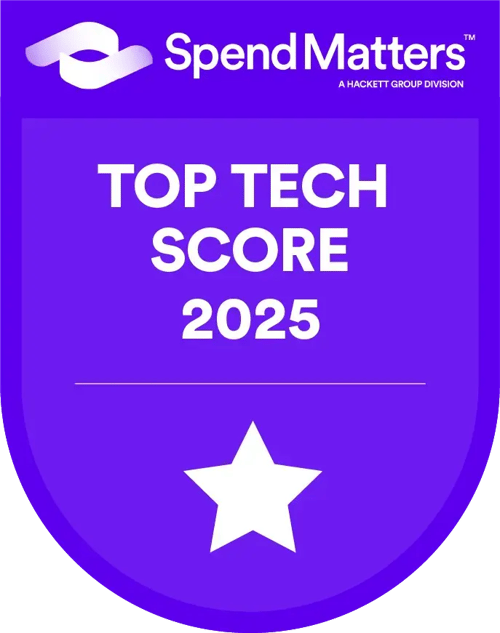By Varvara Kharitonova and Marius Ciobanu. Special thanks to Heta Pirttijärvi.
Agentic AI is making headlines, and for good reason. It's being heralded as the next big leap in the evolution of AI tools. We think the conversation around Agentic AI is particularly relevant to procurement teams. In this article, we’ll show you why.
In our experience, the average procurement team spends the majority of its time gathering and cleansing data, leaving very little time for true strategic analysis and decision-making. This leads to delayed responses due to the time needed to gather and analyze data, which can result in missed opportunities and compliance risks.
Procurement professionals often find themselves buried under mountains of data scattered across their organizations. This fragmentation makes it difficult to see the big picture and make informed decisions.
Even when data is consolidated, there remains a pressing need for robust analytics to guide strategic focus. The key to effective procurement lies in having constant access to the most up-to-date data, ensuring decisions are timely and relevant.
While traditional AI and automation tools can accelerate transactional tasks, they often struggle to deliver nuanced insights that drive transformative procurement strategies.
Agentic AI is a more autonomous form of artificial intelligence designed to analyze data proactively, offer proactive recommendations, and even automate decision-making when appropriate.
In this blog, we'll cover everything about Agentic AI and convince you why you shouldn't ignore it. With special attention to its potential impact and future, differences from traditional AI, and how to implement it, this guide will offer you a starting point for launching your Agentic AI journey.
Watch Webinar: How Agentic AI is Changing Procurement
Key Takeaways
- Agentic AI represents a fundamental shift from passive analytics to proactive, autonomous intelligence that can transform procurement operations.
- Agentic AI is bringing about a new era of decision and process orchestration.
- The technology bridges critical gaps in data utilization, strategic decision-making, and risk management that traditional AI cannot address.
- Successful implementation requires strong data governance, cross-functional collaboration, and balanced human oversight.
Impact of Agentic AI in Procurement
Agentic AI is poised to redefine procurement. It eliminates reliance on manual dashboards, integrates risk management more effectively, and allows procurement teams to harness advanced analytics without requiring specialized AI or data science backgrounds.
Take the case of reducing maverick spending in procurement. Agentic AI can address tail spend and long-tail suppliers through automated compliance checks that continuously monitor purchasing behavior against established procurement policies. The application here represents a profound increase in productivity and compliance:
- Automated policy compliance: The system can enforce procurement policies automatically without requiring manual intervention
- Real-time guidance: Buyers receive immediate feedback when attempting to make purchases outside approved channels
- Continuous learning: The AI system adapts and improves its ability to detect and prevent maverick spending patterns over time
By proactively interpreting data and driving actions, it shifts procurement away from purely reactive tasks toward a more strategic, future-facing function.
How will Agentic AI Change the Role of Procurement?
As AI agents become more adept at autonomous execution, procurement professionals will see their roles evolve toward strategic orchestration and stakeholder management. This shift demands new skill sets encompassing data analytics, advanced negotiation, and cross-functional leadership.
Procurement teams equipped with these capabilities can use AI to explore untapped cost efficiencies, champion sustainability initiatives, and elevate the overall performance of the supply base.
Market conditions can change faster than ever in our interconnected world. The need to stay on top of this volatility has led many market leaders to look to tools such as Agentic AI.
As a technology, Agentic AI’s key business case is to help manage and orchestrate actions within the supply chain at scale while at the same time having high transparency. In turn, this can drive proactive and intelligent supply chain risk management.
What is the Potential ROI of Agentic AI?
The ROI of such an investment can be substantial. The capability to stay ahead during supply chain disruptions represents a significant gain in efficiency while saving vast amounts of time spent in analysis.
Beyond time savings, the financial impact is equally compelling. By adopting Agentic AI in procurement, you can expect to impact savings levers more proactively:
- Finding and extracting relevant data & insights and orchestrating actions
- Reduction in maverick spend through automated compliance checks
- Improved sourcing decisions and insights into alternatives
- Automation and optimization of tail spend
- Improvement in contract terms through AI-powered negotiation support
- Cost avoidance through predictive risk identification
- Faster supplier onboarding and qualification
- And so on…
These efficiency gains translate directly to bottom-line impact, providing a clear ROI that justifies the investment in Agentic AI technology.
Use Cases of Agentic AI
Agentic AI represents a paradigm shift in procurement intelligence—moving from passive reporting to proactive guidance and autonomous action. Unlike conventional AI systems that simply process and present data, Agentic AI can…
- Predict needs before they arise by analyzing patterns across multiple data streams.
- Interpret complex situations by considering market conditions, supplier performance, and business objectives simultaneously.
- Adapt to changing requirements without requiring manual reconfiguration.
- Take action when appropriate, from initiating negotiations to flagging compliance risks.
Agentic AI delivers continuous learning and adaptation to procurement needs but also provides concrete benefits that create immediate value:
Short-term Application (Next 1-2 Years)
- AI Copilot: A procurement assistant especially geared toward data management and guided procurement analytics.
- Simple Conversational Agent: AI agents built for specific tasks that provide conversational support, like invoice management or intake forms.
- Workflow Automation: More sophisticated handling of routine procurement tasks–automatic PO creation, data management, and RFX response analysis.
- Autonomous Sourcing: End-to-end management of certain categories with minimal human intervention.
Long-term Transformation (3-5 Years)
- Predictive Operations: Advanced forecasting of supply chain disruptions before they occur.
- Learning Agent: Agent that gets smarter with more data, assessing patterns in fraud detection and market intelligence.
- Ecosystem Orchestration: Seamless SCM process coordination across multiple systems and stakeholders.
- Strategic Partnership: AI becoming a true thought partner in procurement strategy.
How Agentic AI Differs from Traditional AI
Procurement leaders recognize the strategic importance of data but frequently encounter stumbling blocks in transforming raw information into meaningful action. Traditional tools for procurement analytics generally provide rearward-facing reports.
They may track historical spend and categorize suppliers, but they struggle to integrate real-time data streams or predict future disruptions. These tools predominantly automate mechanical tasks rather than thinking strategically about supplier performance, risk, or contract nuances.
As a result, the potential to drive efficiency and savings stalls short of transformational change. This fragmentation complicates the linking of procurement decisions to corporate objectives, such as sustainability initiatives or risk mitigation strategies.
Agentic AI stands out by proactively taking actions based on its recommendations and insights. Agentic AI aims to predict, interpret, and adapt to changing procurement needs. This capability frees procurement professionals to focus on higher-value activities such as relationship-building, innovation, and long-term planning.
By analyzing market conditions, historical spend, and supplier performance simultaneously, it can initiate negotiations, preempt supply interruptions and risks, or generate fresh ideas for cost savings. This capability addresses a significant gap in proactive decision-making.
Traditional AI vs. Agentic AI in Procurement
|
Capability
|
Traditional AI
|
Agentic AI
|
|
Data Analysis
|
Processes structured data in predefined ways.
|
Holistically integrates diverse data sources and produces dynamic suggestions.
|
|
User Experience
|
Requires users to navigate dashboards and extract and interpret insights.
|
Delivers contextual guidance and recommendations in natural language, with an emphasis on helping orchestrate multiple decisions proactively.
|
|
Decision Support
|
Provides historical reports and basic forecasts.
|
Offers strategic options with projected outcomes and implementation paths.
|
|
Autonomy
|
Executes specific programmed tasks.
|
Initiates actions based on organizational goals and constraints.
|
|
Learning
|
Improves through manual retraining with limited adaptability.
|
Continuously learns from data, interactions, and changing conditions and improves over time.
|
How to Get Started with Agentic AI
Implementing Agentic AI doesn't have to be overwhelming. Here's a practical roadmap:
- Assess Your Readiness: Evaluate your current data quality, team capabilities, and technology infrastructure. Identify specific gaps that need addressing before AI implementation.
- Start Small: Choose a focused use case with clear ROI potential, such as automating routine supplier performance reviews or enhancing spend analytics with predictive insights.
- Build Cross-functional Teams: Include procurement, IT, data science, and business stakeholders to ensure holistic implementation.
- Focus on Change Management: Invest in training programs to build AI literacy among procurement staff. Address concerns about job security openly and emphasize how AI will augment rather than replace human roles.
- Establish Governance: Define clear policies for AI use, including decision authority, data privacy, and ethical guidelines.
- Measure and Iterate: Set specific KPIs to track both short-term efficiency gains and longer-term strategic impact. Use these metrics to continuously refine your approach.
- Partner Strategically: Consider working with specialized AI providers who understand procurement challenges. Look for solutions that offer transparency in how AI makes recommendations.
- Plan for Scale: Once your initial use case proves successful, develop a roadmap for expanding Agentic AI across more procurement use cases.
Remember, successful Agentic AI implementation is as much about people and processes as it is about technology. Organizations that recognize this tend to achieve significantly better results.
Read our AI in Procurement Guide for a full overview of AI use cases in Procurement
Risks and Challenges of Implementing Agentic AI
While the benefits are compelling, organizations must navigate several challenges when implementing Agentic AI:
Data Quality and Governance: Establishing clear data standards for data collection and classification is a non-negotiable step in responsible AI adoption.
Ethical Considerations: Organizations need clear policies on when AI can make autonomous decisions versus and when human intervention is required.
Security and Privacy: Organizations must ensure compliance with relevant data protection regulations.
Skill Gaps: In addition to the challenges associated with data and security, there should also be a concerted effort to train users in how AI and agents can be integrated into their workflows.
Sievo's Approach to AI in Procurement
At Sievo, we're integrating AI capabilities across our procurement analytics platform to help our customers achieve better outcomes. Our approach focuses on practical applications that deliver immediate value while building toward the more autonomous future that Agentic AI promises.

Sievo IQ is our AI assistant that helps procurement teams get more value from their data. It allows users to ask questions in natural language and receive insights in seconds, eliminating the need for complex data queries or extensive training.
Beyond Sievo IQ, we've incorporated AI throughout our platform:
- Cross-customer community data insights
- Automated savings insights delivered around the clock
- Data cleansing and classification
- Material duplication opportunities and harmonization
- GenAI captured public data and signals, like SBTi performance and supplier intelligence
- …and more
We've also developed strategic partnerships with specialized AI providers, such as our integration with Pactum for autonomous supplier negotiations, demonstrating our commitment to bringing the best AI capabilities to procurement.
Sievo is committed to helping procurement teams bridge the data-to-action gap through innovative technology and proven methodologies. Schedule a demo with our experts to discuss your specific procurement challenges and how Agentic AI can address them.



